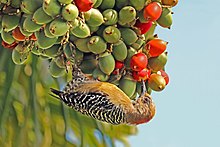| Piciformes Temporal range: Early Eocene to present
| |
|---|---|

| |
| Red-crowned woodpecker Melanerpes rubricapillus rubricapillus female, Tobago | |
| Scientific classification | |
| Domain: | Eukaryota |
| Kingdom: | Animalia |
| Phylum: | Chordata |
| Class: | Aves |
| Clade: | Picodynastornithes |
| Order: | Piciformes Meyer & Wolf, 1810 |
| Suborders and families | |
|
For prehistoric taxa, see text | |
| Synonyms | |
|
Galbuliformes Fürbringer, 1888 | |
Nine families of largely arboreal birds make up the order Piciformes /ˈpɪsɪfɔːrmiːz/, the best-known of them being the Picidae, which includes the woodpeckers and close relatives. The Piciformes contain about 71 living genera with a little over 450 species, of which the Picidae make up about half.
In general, the Piciformes are insectivorous, although the barbets and toucans mostly eat fruit and the honeyguides are unique among birds in being able to digest beeswax (although insects make up the bulk of their diet). Nearly all Piciformes have parrot-like zygodactyl feet—two toes forward and two back, an arrangement that has obvious advantages for birds that spend much of their time on tree trunks[citation needed]. An exception are a few species of three-toed woodpeckers. The jacamars aside, Piciformes do not have down feathers at any age, only true feathers. They range in size from the rufous piculet at 8 centimetres in length, and weighing 7 grams, to the toco toucan, at 63 centimetres long, and weighing 680 grams.[1] All nest in cavities and have altricial young.
- ^ Short, Lester L. (1991). Forshaw, Joseph (ed.). Encyclopaedia of Animals: Birds. London: Merehurst Press. pp. 152–157. ISBN 1-85391-186-0.